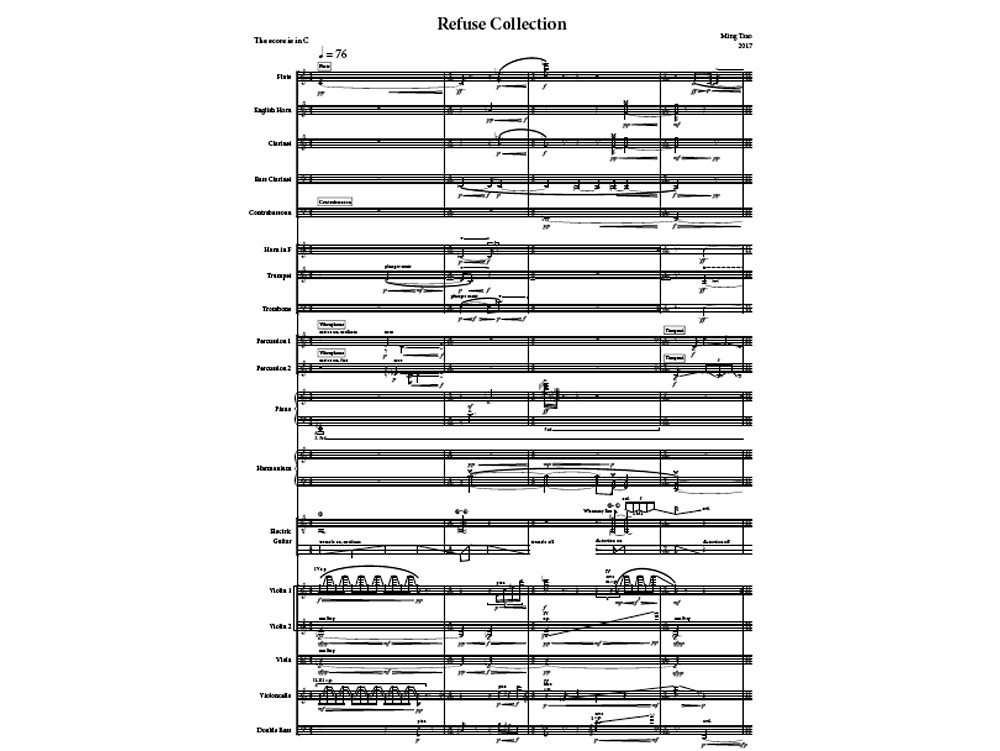Titel: Refuse Collection
Instrumentation: großes Ensemble
Jahr: 2017
Dauer: 12 Min.
Uraufführung: Sagen Sie’s den Steinen Festival: Zur Gegenwart des Werks von Danièle Huillet und Jean-Marie Straub 2017
Interpreten: Kammerensemble Neue Musik Berlin
Drohende Gefahr, Angst, Katastrophe, die Worte, die Schönbergs Begleitmusik zu einer Lichtspielszene Op.34 aus dem Jahr 1930 vortragen, legen nahe, dass nur Musik als nicht-konzeptuelles Medium solche Empfindungen vermitteln kann. Straub-Huillet’s Einleitung zu Arnold Schönbergs Begleitmusik zu einer Lichtspielszene (1973) ist eine desynchronisierte Reaktion auf diese Musik – selbst eine Begleitung – durch die dialektische Zusammenführung einer Reihe von Gegenstrategien (wie Interviews, Fotomontagen, Dokumentationen, Texten, etc.) der Versuch, ein „Bild“ zu schaffen, das durch das sich weigern der homogenisierten Darstellungskräfte die Sensationen von Schönbergs Musik einfängt.
Ein jüngeres Beispiel ist die Poesie von J.H. Prynne, insbesondere seine Refuse Collection (2004), in der die Parataxe einer lyrisch–poetischen Sprache mit dokumentarischen Zitaten aus der Alltagssprache des Kapitalismus und der Medienvertretung versucht, ein „Bild“ einer weiteren Katastrophe, der Gräueltaten von Abu Ghraib im Irak zu schaffen. Eine solche poetische Sprache wird durch einen formalen Sinn des poetischen Rhythmus vermittelt, ähnlich wie Straub-Huillets formaler Sinn für den filmischen Rhythmus. Ähnlich der Spannung, die zwischen den Aufnahmen in Straub-Huillets Film über die Montage entsteht, situiert Prynne die Spannung zwischen und über den Linienenden, wo es eine Art dialektische Unruhe gibt, weil Linienendungen und Verseinteilungen in und gegen semantische Überlastung arbeiten. Ich denke, dass die Parameter von Rhythmus und Metrum und ihr Potential, Energie, Kraft und Gewalt zu erzeugen, Schlüsseleigenschaften sowohl von Prynnes als auch von Straub-Huillet’s Arbeit und Parametern sind, die viele meiner eigenen musikalischen Kompositionen beeinflussen.
Meine musikalische Komposition für 18 Musiker, „Refuse Collection“, ist ein Versuch, Schönbergs Musik, Straub-Huillets Film und Prynnes Gedicht unter die Rubrik einer spekulativen Musik zu setzen, die Schönbergs Opus 34 durch die rhythmischen und metrischen Kräfte von Prynnes Gedicht transkribiert, so das der Zuhörer eine Gegenmelodie gegen die Originalmusik als Begleitmusik zu den Kräften des Originalwerkes hört. Die Idee einer Begleitmusik beginnt, die Narben der Originalmusik unter dem Druck der Homogenisierungskräfte nicht als Begleitung zu zeigen (wie es in Straub-Huillets Film brillant vermittelt wird). In der Tat wird spekulative musikalische Komposition in Schönbergs theoretischen Schriften exemplarisch dargestellt, da sie die wahre Natur von „Begleitung“ als Kontrapunkt (ein inhärentes „gegen–arbeiten“) aufzeigen, so dass beim Hören genügend Widerstand geleistet wird, um der anhaltenden Nachfrage nach menschlichen Angelegenheiten in einer fühlbarer Textur gerecht zu werden.
Die Natur meiner Komposition „Refuse Collection“ suggeriert die Wiederverwendung von weggeworfenen Materialien als „Verschwendung“ durch eine diskontinuierliche Montage von musikalischen Fragmenten, die alle auf Schönbergs Musik basieren, deren Natur aber von Prynnes Gedicht geprägt ist. Abfall bedeutet Geräusch, Überfluss und Müll, der als Rüge und Herausforderung für instrumentelle Systeme steht, denn Müll ist das, was übrig bleibt, wenn der Betrieb der Homogenisierungskräfte abgeschlossen ist und nichts mehr übrig bleiben sollte. In der Tat kann das Geräusch, das ein Produkt der Materialität der Musik ist, sich auf die angesammelten Signifikanzschichten abstimmen, die durch die Evolution der Musik entstanden sind, und frühere Codes als die Kontamination beschädigter Formen reaktivieren. Eine solche Überarbeitung von Schönbergs Opus 34 versucht ein anderes „Bild“ von drohende Gefahr, Angst, Katastrophe zu schaffen, das durch die Risse und groben Texturen von Schönbergs Originalmusik definiert wird.
Die resultierende Musik würde, wie ich hoffe, eine materialistische Musik nahe legen, die Straubs Vorstellung eines „materialistischen Bildes“ ähnelt – einer Klangwelt außerhalb des Bewusstseins und nicht einer mit Bewusstsein ausgestatteten Klangwelt, die den Zuhörer in einen Raum stellt, in dem wir unsere Persönlichkeit in einem größeren Zusammenhang zum Leben überdenken müssen. Ich glaube, dass die heutige Musikzusammensetzung die Zuhörer dazu bringen sollten, über anthropozentrische Begriffe hinaus zu hören, einschließlich der Art und Weise, wie der Widerstand in der Welt – seine widersprüchliche und dynamische Materialität – konzeptionelles Denken und technologische Kontrolle übersteigt und einen Kontrapunkt zu unserem zeitgenössischen Ortsverständnis bildet, wo musikalische Lyrik sensibel für die Beziehungen zwischen menschlichem Einfluss und Präsenz in unserer mehr als menschlichen Welt ist.
Link: www.wisemusicclassical.com/work/67850/Refuse-Collection–Ming-Tsao/


